INSTITUIT SUPERIEUR D'ANTHROPOLOGIE
INSTITUT OF ANTHROPOLOGY
COURS ONLINE – COURS A DISTANCE
INSCRIPTIONS : SEPTEMBRE 2023
REGISTER NOW
ESPAGNE –  Cavandi - Sergio Narciandi was working on some pipes in the municipality of Cavandi in Asturias, northwest Spain on August 29 when he came across the unusual find, El Pais reported. Picking up the shiny object, he realized it was a torc—an ancient neck ornament, similar to necklaces, which were typically worn by nobles. He then found another piece of jewelry of a similar type. They are believed to be from the Iron Age. Archaeologists from the Archaeological Museum of Asturias were notified, who took a closer look at the strange discovery and called in experts from institutions in northern Spain. "This discovery is very important because, for the first time, we know the exact origin of two of these valuable objects, the maximum symbol of prestige for pre-Roman communities, and the context in which they were deposited. The Iron Age lasted from around the 5th to the 2nd century BC. Torcs were usually made of expensive materials and were most commonly worn by Celtic and Germanic nobles.The ones found have a style typical to those worn by nobles in the Iron Age throughout the Iberian Peninsula, El Pais reported. Strangely, there were no other archaeological artifacts found around the same area.
Cavandi - Sergio Narciandi was working on some pipes in the municipality of Cavandi in Asturias, northwest Spain on August 29 when he came across the unusual find, El Pais reported. Picking up the shiny object, he realized it was a torc—an ancient neck ornament, similar to necklaces, which were typically worn by nobles. He then found another piece of jewelry of a similar type. They are believed to be from the Iron Age. Archaeologists from the Archaeological Museum of Asturias were notified, who took a closer look at the strange discovery and called in experts from institutions in northern Spain. "This discovery is very important because, for the first time, we know the exact origin of two of these valuable objects, the maximum symbol of prestige for pre-Roman communities, and the context in which they were deposited. The Iron Age lasted from around the 5th to the 2nd century BC. Torcs were usually made of expensive materials and were most commonly worn by Celtic and Germanic nobles.The ones found have a style typical to those worn by nobles in the Iron Age throughout the Iberian Peninsula, El Pais reported. Strangely, there were no other archaeological artifacts found around the same area.
Waste Worker Discovers 'Spectacular' 2,500-Year-Old Gold Necklaces (newsweek.com)
TURQUIE –  Aşağıseyit Höyük - Archaeologists at the Aşağıseyit Höyük (Aşağıseyit Mound) site in western Anatolia’s Denizli have uncovered a 3,500-year-old grape seed. Aşağıseyi Höyük Settlement is located within the boundary of Çal district of Denizli Province. It was strategically located on a natural passage and an important center surrounded by walls during the 2nd millennium BC. Surveys conducted in the Upper Menderes Basin have revealed that the mountainous and plateau areas are at least as densely settled as in lowland sections and these areas have significant importance in archaeological point of view. Among the finds reached by the excavation team this year, the remains of grape seeds dating back 3,500 years stand out. The significance of the discoveries made during the excavation was highlighted, and Konakçı noted: “We have reached layers dating back to as early as 1600 B.C. Surface surveys have already indicated that the history of this mound extends back to the late Chalcolithic period. Furthermore, we are aware of the existence of settlements during both the early and late Bronze Ages. We anticipate further exploration in the coming years to delve into these layers.” Konakçı also revealed that during the excavation, they had identified two phases dating to the Late Bronze Age, between the 12th and 16th centuries B.C., and discovered structures, hearths and ovens from these periods. These findings have been evaluated by archaeozoologists and archaeobotanists. Regarding the plant species and seed types used during both the Hellenistic and Late Bronze Ages in the region, Konakçı stated: “We have acquired data suggesting the consumption of barley and wheat. A single grape seed was found, providing new insights into grape consumption in the region around 1500 B.C. As you may know, there is a long history of grape cultivation and winemaking along the western coast of Anatolia and central Anatolia. We are aware of the crucial role grapes play in interregional trade. The discovery of a grape seed aligns with this broader historical context.”
Aşağıseyit Höyük - Archaeologists at the Aşağıseyit Höyük (Aşağıseyit Mound) site in western Anatolia’s Denizli have uncovered a 3,500-year-old grape seed. Aşağıseyi Höyük Settlement is located within the boundary of Çal district of Denizli Province. It was strategically located on a natural passage and an important center surrounded by walls during the 2nd millennium BC. Surveys conducted in the Upper Menderes Basin have revealed that the mountainous and plateau areas are at least as densely settled as in lowland sections and these areas have significant importance in archaeological point of view. Among the finds reached by the excavation team this year, the remains of grape seeds dating back 3,500 years stand out. The significance of the discoveries made during the excavation was highlighted, and Konakçı noted: “We have reached layers dating back to as early as 1600 B.C. Surface surveys have already indicated that the history of this mound extends back to the late Chalcolithic period. Furthermore, we are aware of the existence of settlements during both the early and late Bronze Ages. We anticipate further exploration in the coming years to delve into these layers.” Konakçı also revealed that during the excavation, they had identified two phases dating to the Late Bronze Age, between the 12th and 16th centuries B.C., and discovered structures, hearths and ovens from these periods. These findings have been evaluated by archaeozoologists and archaeobotanists. Regarding the plant species and seed types used during both the Hellenistic and Late Bronze Ages in the region, Konakçı stated: “We have acquired data suggesting the consumption of barley and wheat. A single grape seed was found, providing new insights into grape consumption in the region around 1500 B.C. As you may know, there is a long history of grape cultivation and winemaking along the western coast of Anatolia and central Anatolia. We are aware of the crucial role grapes play in interregional trade. The discovery of a grape seed aligns with this broader historical context.”
3500-year-old grape seed remains found in western Anatolia - Arkeonews
ANGLETERRE – 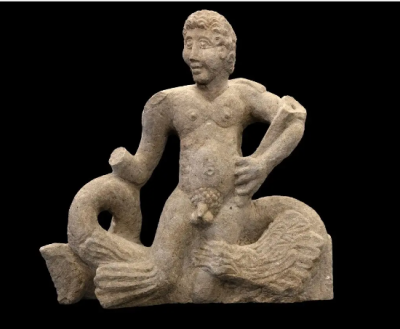 Teynham - In a press statement by the Chartway Partnerships Group, archaeologists discovered a mausoleum set in a walled and ditched enclosure adjacent to the A2 London Road (which follows Roman Watling Street) at Teynham in Kent. Robert Masefield, Director for RPS, said: “We expected interesting Roman archaeology, perhaps a cemetery, but the finds including the lively and unique statue of a Triton and the mausoleum remains have by far exceeded that. These finds are now part of Teynham’s local legacy and the nations rich Roman story. Further study will place the findings in their full historical context.” Triton was the god of the sea from the Greek pantheon, and the son of Poseidon and Amphitrite. Greek and Roman depictions of Triton generally represent the god as a merman, with the lower half being that of a fish, while the top half is presented in a human figure. According to the researchers, the site could be a mausoleum from during the early to mid-4th century AD (dating evidenced by the discovery of a coin in the demolition fill). Several Roman and possibly later burials were also identified during the excavation within and adjacent to the structures. The most notable discovery is a statue of Triton, which was found ritually placed within a disused clay-lined water tank on the south-east corner of an outer ditched enclosure. According to the press statement: “These associations suggest the enclosure complex and central mausoleum was a funerary site of a wealthy local family (possibly associated with a Roman villa found previously at Bax Farm further to the north) and dedicated to Roman maritime deities.”
Teynham - In a press statement by the Chartway Partnerships Group, archaeologists discovered a mausoleum set in a walled and ditched enclosure adjacent to the A2 London Road (which follows Roman Watling Street) at Teynham in Kent. Robert Masefield, Director for RPS, said: “We expected interesting Roman archaeology, perhaps a cemetery, but the finds including the lively and unique statue of a Triton and the mausoleum remains have by far exceeded that. These finds are now part of Teynham’s local legacy and the nations rich Roman story. Further study will place the findings in their full historical context.” Triton was the god of the sea from the Greek pantheon, and the son of Poseidon and Amphitrite. Greek and Roman depictions of Triton generally represent the god as a merman, with the lower half being that of a fish, while the top half is presented in a human figure. According to the researchers, the site could be a mausoleum from during the early to mid-4th century AD (dating evidenced by the discovery of a coin in the demolition fill). Several Roman and possibly later burials were also identified during the excavation within and adjacent to the structures. The most notable discovery is a statue of Triton, which was found ritually placed within a disused clay-lined water tank on the south-east corner of an outer ditched enclosure. According to the press statement: “These associations suggest the enclosure complex and central mausoleum was a funerary site of a wealthy local family (possibly associated with a Roman villa found previously at Bax Farm further to the north) and dedicated to Roman maritime deities.”
Archaeologists find statue of Triton in Roman mausoleum | HeritageDaily - Archaeology News
MEXIQUE – 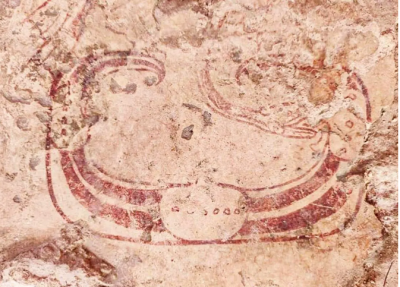 Ekʼ Balam - Ekʼ Balam was a Maya city in the municipality of Temozón, Yucatán, Mexico. The city was occupied from the Middle Preclassic through the Postclassic, although it ceased to thrive as a major centre following the Late Classic. The city consists of pyramidal platform temples, plazas, palaces, ballcourts, and a large central Acropolis. It is theorised that the city was hastily abandoned during a period of strife and great conflict. Excavations conducted in the east-elevated plaza of the Acropolis has led to the discovery of a painted vault lid. The lid has a red “U”-shaped symbol, which according to the researchers is a representation of a cave, a possible allusion for the Maya underworld. Similar examples of vault lids have been previously discovered in the Ekʼ Balam archaeological zone, providing archaeologists the names of several rulers of the city, in addition to information on construction dates of rooms in the royal palace and Acropolis. The latest vault lid discovery also features the head and body of a serpent, which may be associated with K’awiil, a Maya god of lightning, serpents, fertility and maize. According to Leticia Vargas de la Peña and Víctor Castillo Borges, Directors of the Ek’ Balam Archaeological Project: “This discovery provides new information about the builders of the elite enclosures of the east elevated plaza of the Acropolis, as well as evidence to date when they were erected.”
Ekʼ Balam - Ekʼ Balam was a Maya city in the municipality of Temozón, Yucatán, Mexico. The city was occupied from the Middle Preclassic through the Postclassic, although it ceased to thrive as a major centre following the Late Classic. The city consists of pyramidal platform temples, plazas, palaces, ballcourts, and a large central Acropolis. It is theorised that the city was hastily abandoned during a period of strife and great conflict. Excavations conducted in the east-elevated plaza of the Acropolis has led to the discovery of a painted vault lid. The lid has a red “U”-shaped symbol, which according to the researchers is a representation of a cave, a possible allusion for the Maya underworld. Similar examples of vault lids have been previously discovered in the Ekʼ Balam archaeological zone, providing archaeologists the names of several rulers of the city, in addition to information on construction dates of rooms in the royal palace and Acropolis. The latest vault lid discovery also features the head and body of a serpent, which may be associated with K’awiil, a Maya god of lightning, serpents, fertility and maize. According to Leticia Vargas de la Peña and Víctor Castillo Borges, Directors of the Ek’ Balam Archaeological Project: “This discovery provides new information about the builders of the elite enclosures of the east elevated plaza of the Acropolis, as well as evidence to date when they were erected.”
Painted vault lid found depicting a serpent and the underworld | HeritageDaily - Archaeology News
BULGARIE –  Teketo - A Thracian tomb from the time of the Odrysian kingdom was discovered by archaeologists near the village of Teketo, Haskovo region, southern Bulgaria. The researchers uncovered wall paintings destroyed by treasure hunters. Despite the damages, the condition of the tomb surprised the archaeologists. However, it will provide valuable information for science and open a new chapter in the history of the Odrysians. "It is curious to show you a situation that puzzles us too. Here we see fragments of protective clothing, under this block. This is a chasuble that is constructed of small plates that are sewn to a leather or cloth garment. We see 7-8 of them here," said Assoc. Prof. Georgi Nehrizov, head of the archaeological excavations.
Teketo - A Thracian tomb from the time of the Odrysian kingdom was discovered by archaeologists near the village of Teketo, Haskovo region, southern Bulgaria. The researchers uncovered wall paintings destroyed by treasure hunters. Despite the damages, the condition of the tomb surprised the archaeologists. However, it will provide valuable information for science and open a new chapter in the history of the Odrysians. "It is curious to show you a situation that puzzles us too. Here we see fragments of protective clothing, under this block. This is a chasuble that is constructed of small plates that are sewn to a leather or cloth garment. We see 7-8 of them here," said Assoc. Prof. Georgi Nehrizov, head of the archaeological excavations.
Archaeologists discover a Thracian tomb from the time of the Odrysian kingdom near Haskovo - Българска национална телевизия (bnt.bg)
CHINE – Zhengzhou - A water system from more than 3,600 years ago has been discovered in central China's Henan Province. This find will improve people's understanding of the city layout back then. Three ditch sections were found in the ruins of a city from the Shang Dynasty (1600-1046 B.C.) in Zhengzhou, capital of Henan. Together these sections form the largest water system from the early period of the Shang Dynasty to be discovered thus far.According to local archaeologists, one of the sections was built on a natural river channel, while the remaining two were entirely artificial. About 540 meters of ditches were unearthed, with a width of about 12 meters at the widest point, and a depth of roughly four meters at its deepest point. "Based on our study of spatial positions and cultural relics recovered from the ditches, we believe that they were interconnected and belonged to a large water system, which demonstrated the grandeur of a Shang capital," said Yang Wensheng, vice director of the Henan Provincial Institute of Cultural Heritage and Archaeology. Ruins of the city covered about 25 square kilometers, and it is believed to be a former Shang capital built by Emperor Tang, the first emperor of the Shang Dynasty. In one of the ditch sections, archaeologists found artificial open channels and stone facilities for water diversion, indicating that in the early Shang Dynasty, there had already been complex functional design of the water system. Remains of handicraft workshops for copper casting and making bone objects were also found. The ditches were connected with ponds and gardens in the northern parts of the city, which means that water in the system supplied not only production and life in the city, but was also used for landscaping of the city. "Discovery of this water system enhanced our understanding of the layout of the ancient city, which is of significance for in-depth study of city planning and functional zones division in the early Shang Dynasty capital," said Yang Shugang of the Henan Provincial Institute of Cultural Heritage and Archaeology. ■
Water system from early Shang Dynasty discovered in central China-Xinhua (news.cn)
INDE – 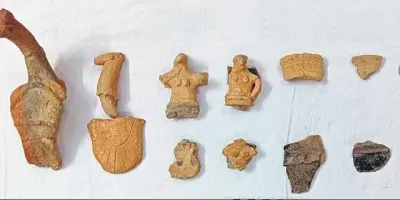 Mudukonaje -Eight terracotta figurines have been found in the megalithic dolmens of Mudukonaje which dated back to 800-700 BC, said Murugeshi, T, a retired associate professor of Ancient History and Archeology in a statement. Of them, two are cow bovines, one mother goddess, two peacocks, a horse, a hand of a mother goddess and an unknown object. He said these were found inside the dolmens, which were disturbed by treasure hunters. “It was the first time in India cow bovines were found in the dolmens and it will determine the chronology of the dolmens. Terracottas found in the megalithic burial provide a solid ground for studying the Bhoota cult or Daiva Aradhane of coastal Karnataka. Cow bovine or cow goddess had its parallels in Malampuzha Megalithic terracotta figurines of Kerala and also Egypt,” Murugeshi elaborated.
Mudukonaje -Eight terracotta figurines have been found in the megalithic dolmens of Mudukonaje which dated back to 800-700 BC, said Murugeshi, T, a retired associate professor of Ancient History and Archeology in a statement. Of them, two are cow bovines, one mother goddess, two peacocks, a horse, a hand of a mother goddess and an unknown object. He said these were found inside the dolmens, which were disturbed by treasure hunters. “It was the first time in India cow bovines were found in the dolmens and it will determine the chronology of the dolmens. Terracottas found in the megalithic burial provide a solid ground for studying the Bhoota cult or Daiva Aradhane of coastal Karnataka. Cow bovine or cow goddess had its parallels in Malampuzha Megalithic terracotta figurines of Kerala and also Egypt,” Murugeshi elaborated.
Terracotta figurines dating back to 700 BCE found in Karnataka's Dakshina Kannada district- The New Indian Express
POLOGNE – 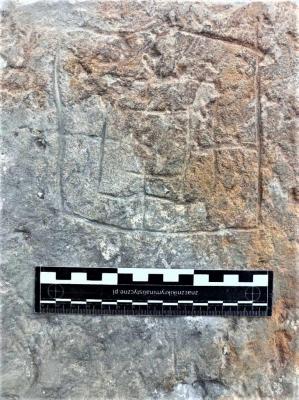 Ćmielów - A board game carved into stone was discovered by archaeologists investigating the castle at Ćmielów in the Świętokrzyskie Voivodeship in Poland. The board game was probably created in the 16th century. Carved into a sandstone floor slab by the castle’s original builders, the game was discovered by archaeologist Tomasz Olszacki. The board game is located on a damaged sandstone slab, measuring approximately 32 cm and its thickness varies from 6 to 12 cm. The playing field itself measures approximately 13.5 cm. Olszacki told National Geographic Polska that the game could have been carved by construction workers seeking to gamble their earnings in their spare time. According to Olszacki, though, the game could just have easily been carved in later years by children or servants. Although its exact origins are unknown, it appears certain that the game itself was called Mill, a strategy board game with ancient origins – aside from being enjoyed by the Romans, Confucius is also thought to have been a player. Contested between two players, it was also known as Nine Men’s Morris, Merels, and Ninepenny Marl. Similar “boards” are known mainly from medieval England. They were also carved in castles in Italy and in Crusader castles. It is not clear whether these types of boards were actually used for games or whether they carried a symbolic, perhaps magical message.
Ćmielów - A board game carved into stone was discovered by archaeologists investigating the castle at Ćmielów in the Świętokrzyskie Voivodeship in Poland. The board game was probably created in the 16th century. Carved into a sandstone floor slab by the castle’s original builders, the game was discovered by archaeologist Tomasz Olszacki. The board game is located on a damaged sandstone slab, measuring approximately 32 cm and its thickness varies from 6 to 12 cm. The playing field itself measures approximately 13.5 cm. Olszacki told National Geographic Polska that the game could have been carved by construction workers seeking to gamble their earnings in their spare time. According to Olszacki, though, the game could just have easily been carved in later years by children or servants. Although its exact origins are unknown, it appears certain that the game itself was called Mill, a strategy board game with ancient origins – aside from being enjoyed by the Romans, Confucius is also thought to have been a player. Contested between two players, it was also known as Nine Men’s Morris, Merels, and Ninepenny Marl. Similar “boards” are known mainly from medieval England. They were also carved in castles in Italy and in Crusader castles. It is not clear whether these types of boards were actually used for games or whether they carried a symbolic, perhaps magical message.
500-year-old board game discovered carved into a stone slab in a Polish castle - Arkeonews
MEXIQUE - 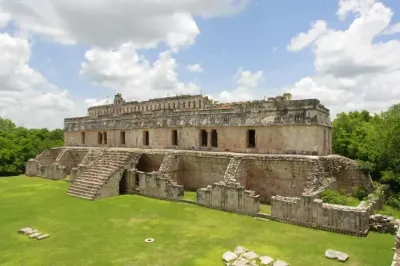 Kabah - Archaeologists have discovered a palace at an ancient Maya city in southeastern Mexico that shares characteristics with ruins in neighboring Guatemala, which could point to an "important" period of migration thousands of years ago. The palace was found in the archaeological zone of Kabah—a pre-Hispanic settlement located in the Puuc region of Yucatán state, south of the modern city of Mérida—the Mexican National Institute of Anthropology and History (INAH) has announced. Kabah, which lies around 50 miles away from Mérida, contains a number of structures, including palaces and temples dedicated to Chaac, the Maya god of rain. The name of the settlement translates to "strong" or "powerful" hand in the ancient Maya tongue. Artifacts found in various parts of the site indicate that the history of Kabah dates back to around 400 B.C., according to INAH. At that time, the site must have only been home to a small community of hunter-gatherers, since no significant architectural works dated to this period have been found. In the following centuries, the development of Kabah appears to have been slow, with the lack of permanent water sources limiting population growth. The first evidence of monumental architecture at the site that archaeologists have found dates back to around 400 A.D. The newly discovered palace has a main facade composed of a portico with eight pilasters—shallow, decorative columns attached to a wall—and nine openings, as well as an extension of 85 feet, INAH general director Diego Prieto Hernández said. Researchers have named the newly uncovered Maya remains Petenero Palace. Hernández said the quadrangular structure appears to be more than 1,500 years old. The palace was decorated with motifs of feathers, beads and birds that were carved into its architecture. Researchers think the roof of the building was made with a perishable material, such as guano palm, which has not survived. The palace shares some characteristics with Maya remains found in the Petén Department of Guatemala, Hernández said.
Kabah - Archaeologists have discovered a palace at an ancient Maya city in southeastern Mexico that shares characteristics with ruins in neighboring Guatemala, which could point to an "important" period of migration thousands of years ago. The palace was found in the archaeological zone of Kabah—a pre-Hispanic settlement located in the Puuc region of Yucatán state, south of the modern city of Mérida—the Mexican National Institute of Anthropology and History (INAH) has announced. Kabah, which lies around 50 miles away from Mérida, contains a number of structures, including palaces and temples dedicated to Chaac, the Maya god of rain. The name of the settlement translates to "strong" or "powerful" hand in the ancient Maya tongue. Artifacts found in various parts of the site indicate that the history of Kabah dates back to around 400 B.C., according to INAH. At that time, the site must have only been home to a small community of hunter-gatherers, since no significant architectural works dated to this period have been found. In the following centuries, the development of Kabah appears to have been slow, with the lack of permanent water sources limiting population growth. The first evidence of monumental architecture at the site that archaeologists have found dates back to around 400 A.D. The newly discovered palace has a main facade composed of a portico with eight pilasters—shallow, decorative columns attached to a wall—and nine openings, as well as an extension of 85 feet, INAH general director Diego Prieto Hernández said. Researchers have named the newly uncovered Maya remains Petenero Palace. Hernández said the quadrangular structure appears to be more than 1,500 years old. The palace was decorated with motifs of feathers, beads and birds that were carved into its architecture. Researchers think the roof of the building was made with a perishable material, such as guano palm, which has not survived. The palace shares some characteristics with Maya remains found in the Petén Department of Guatemala, Hernández said.
Archaeologists Discover 1,500-Year-Old Palace at Ancient Maya City (newsweek.com)